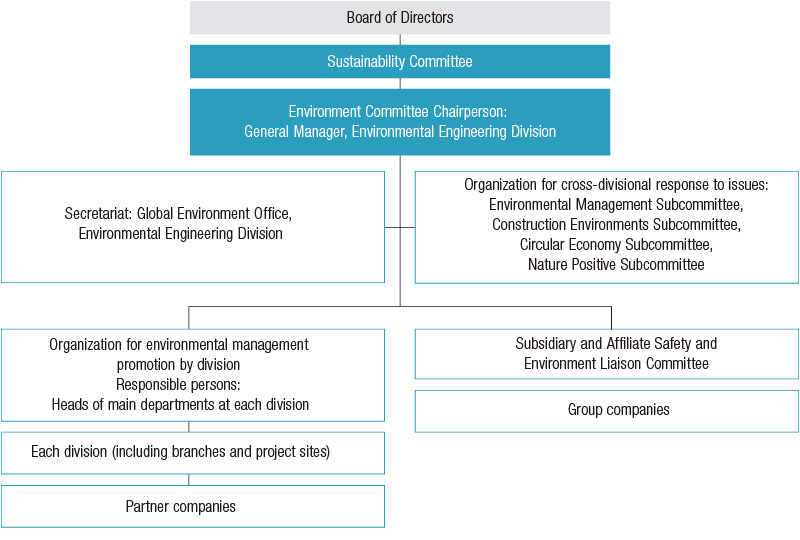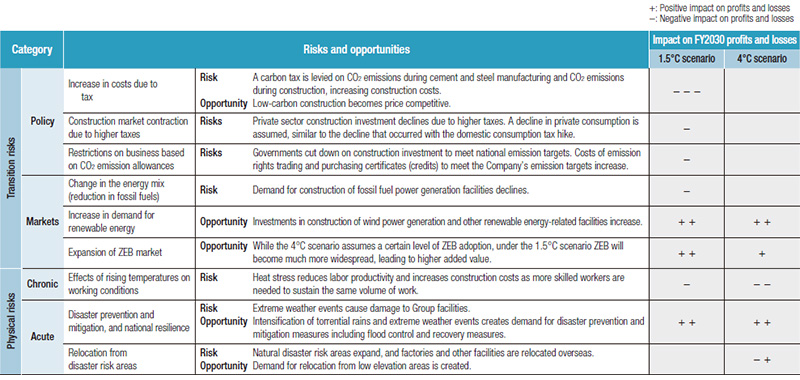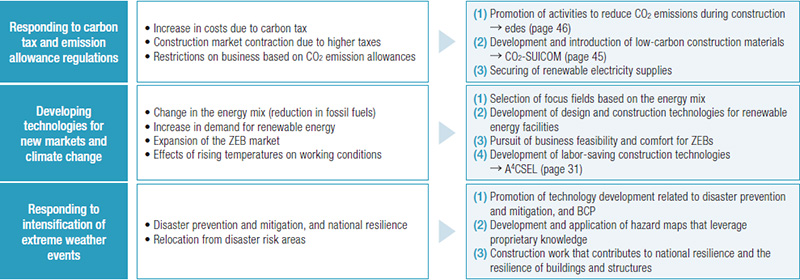Disclosure of information under the TCFD
Kajima recognizes that addressing environmental issues including climate change is a key management issue and includes “providing technologies and services for disaster preparedness that support safety and security” and “contributing to society’s transition to a carbon-free footprint” among its material issues. In December 2019, Kajima expressed its support for the recommendations of the Task Force on Climate-related Financial Disclosures (TCFD).
While society and markets are increasingly committed to decarbonization, the world is already experiencing extreme weather events and floods that are becoming more severe. We will continue to contribute to the resolution of social issues related to climate change through our businesses. This includes contributing to the social mission of the construction industry in terms of disaster prevention and mitigation, BCP and disaster recovery.

Governance
Important policies and measures related to the environment, including responses to climate change, are discussed and decided on by the Sustainability Committee, which is chaired by the President. The committee reports the details of those discussions and other information regularly (about twice a year) to the Board of Directors, which then discusses and makes decisions on particularly important policies. In addition, in order to ensure substantial discussions and flexible follow-up, the Environment Committee has been established as a special-purpose subcommittee under the Sustainability Committee and comprises the heads of business divisions and the general managers of related departments as members. Under Medium-Term Business Plan (FY2024–2026), carbon neutrality measures are positioned as a priority initiative, and as such their implementation has been incorporated into each department’s business plan. Moreover, the Sustainability Committee and the Environment Committee will continue to work through the PDCA cycle, which will lead to further improvements and new initiatives.

Strategy
The construction industry uses materials that conventionally emit a large amount of greenhouse gases during manufacture, such as cement and steel, and the long operating life of buildings and structures has a significant impact on the greenhouse gas emissions of customers. Accordingly, public policies related to carbon pricing and carbon emissions, zero energy buildings (ZEB) and renewable energy-related construction markets, and low-carbon construction technologies are identified as highly relevant transition risks and opportunities. Due to the social mission of the construction industry, which includes contributing to disaster prevention and mitigation, as well as the frequent outdoor work characteristic of the industry, the impact of changing weather patterns, the intensification of extreme weather events, the effect of rising temperatures on labor productivity, and corresponding labor legislation are identified as physical risks and opportunities.
In March 2021, Kajima revised the setting of the 2°C scenario to a 1.5°C scenario and estimated the impact on domestic construction projects in fiscal 2030.
- 1.5°C scenario※1
Scenario in which strict measures are taken against climate change, and the temperature increase in 2100 is limited to about 1.5°C above pre-industrial levels.※1 Parameters used to calculate impact are based on the Sustainable Development Scenario in the World Energy Outlook 2018, International Energy Agency (IEA),Japan’s Long-term Strategy under the Paris Agreement, Japan’s Ministry of the Environment, and other references.
- 4°C scenario※2
Scenario in which strict measures are not taken against climate change, and the temperature increase in 2100 reaches about 4°C above pre-industrial levels.※2 Parameters used to calculate impact are based on The Aqueduct Global Flood Analyzer, World Resources Institute (WRI), Working on a warmer planet, International Labour Organization (ILO), and other references.
Risks and Opportunities

Countermeasures

Specific examples of countermeasures
Activities to reduce CO2 emissions during construction
- Environmental Data Evaluation System (edes)
Low-carbon construction materials
- New wood construction technologies
- Eco-friendly concrete Ecocrete® R3
- CO2-SUICOM
Technology development for designing and constructing renewable energy facilities
- Renewable energy technologies
- Construction of offshore wind power generation facilities at Akita Port and Noshiro Port
- Construction of a multi-purpose SEP crane vessel (lifting capacity of 1,600 t)
Development of labor-saving construction technologies
- Automation of civil engineering work
- Kajima Smart Future Vision
Promotion of technological development related to disaster prevention and mitigation and BCP
- Durability assessment tool: LIFE D.N.A.®
- Tension management system using optical fiber
Building and using hazard maps featuring our own insight
- Evaluating and managing risk: natural disaster risk assessment
- River water level prediction system
- Urban water damage prediction and analysis system
Risk Management
The Global Environment Office of the Environmental Engineering Division, which serves as the secretariat for the Environment Committee, leads cross-organizational assessments of environmental impact by the Environmental Management Subcommittee and other relevant internal departments. Lastly, the Environment Committee deliberates on and determines risks and opportunities.
All operational risks, including climate change-related risks, are assessed by the Compliance and Risk Management Committee, which is chaired by the President, and reported to the Board of Directors twice a year. In addition, Kajima is working to further improve its disaster preparedness and business continuity capabilities through means such as practical BCP drills for torrential rain and other scenarios.
Indicators and Targets
In 2024, we updated the Kajima Environmental Vision: Triple Zero 2050, established in 2013, titling the new vision the Kajima Environmental Vision 2050plus.
Regarding CO2 emission reduction, Kajima has set targets to reduce Scope 1 and 2 emissions by 42% and Scope 3 emissions by 25% by FY2030 compared to FY2021 levels and to achieve net zero emissions and carbon neutrality by FY2050. The company has also established various benchmarks to achieve these targets.
